Tiny plankton could have a big impact on Earth’s climate
13 September 2013
In the oceans there are millions of living things, including some so small we can’t see them! Some crawl along the sea floor, or cling to a rocky holdfast, and others – called plankton – just drift with the currents. Plankton can be broadly split up into zooplankton (animals) and phytoplankton (plants). Both are the main food source for lots of other living things in the sea, and form the basis of the ocean’s food chain. Without plankton, the stability of the oceans and the animals and plants that live in them would be at risk. Scientists have recently investigated what will happen to plankton in the oceans when there is much more carbon dioxide in the atmosphere than there is today. Industrial processes release this gas into the atmosphere, where it contributes to the heating up of our planet in a process called global warming. German scientist Ulf Riebesell and his team of 35 researchers have found that many small species of phytoplankton – those less than half the width of a human hair – love an increase in carbon dioxide. When carbon dioxide dissolves into the ocean from the atmosphere, it provides them with more carbon to make their food. However, a large increase in these tiny phytoplankton can have a knock on effect on other organisms in the sea. Ulf’s team found that the ‘bloom’ of certain types of very small phytoplankton actually removes nutrients from the ocean that other larger phytoplankton need to survive. When they die, plankton carry carbon to the bottom of the ocean, where it is locked away for millions of years. Bigger plankton sink faster, so carry more carbon to the depths: if there are fewer of them, the global carbon cycle suffers. If less carbon is locked away in the oceans, global warming can become an even bigger problem. This research carried out by Ulf and his team is extremely important in helping us understand the complicated processes that go on around us. This knowledge can help us make changes to ensure that we do not disturb the ocean or the organisms that live in it or rely on it (including us!).Find out more
What are phytoplankton?
Plankton comes from the Greek ‘planktos’, which means drifter. All plankton are animals that drift along with the currents, rather than choosing where they would like to go and having the limbs and fins needed to get there.
Phytoplankton are plants that grow using light energy from the sun and carbon dioxide that has dissolved in water from the atmosphere to produce their own food (carbohydrates, consisting of carbon, hydrogen and oxygen) using a process called photosynthesis.
There are lots of different types of phytoplankton in the oceans, which can be classified by their size, some of the smallest being picoplankton. The next smallest group, but bigger than picoplankton is nanoplankton. Within these groups the plankton can also be classified further into plankton with interesting names like flagellates and chrysophytes. An important type of phytoplankton are diatoms. Diatoms, like other phytoplankton, make their food using photosynthesis. In this process they trap organic carbon in their bodies and because there are so many diatoms in the oceans, they account for 40% of all organic carbon produced in the oceans every year!
How do plankton lock carbon away in the deep oceans?
When diatoms die, they sink to the bottom of the ocean as their shells (which are made out of a substance called silica) are very heavy, taking the carbon in their bodies with them. This then locks away the carbon, not to be released back into the atmosphere as carbon dioxide or methane for millennia.
Print version
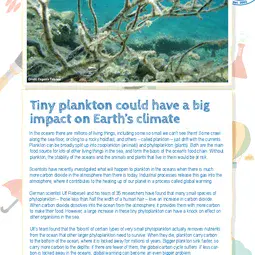
This is a kids' version of the EGU article: 'Tiny plankton could have a big impact on Earth’s climate'. It was written by Jane Robb and reviewed for scientific and educational content by Sara Mynott and Sally Dengg, respectively.
Translations
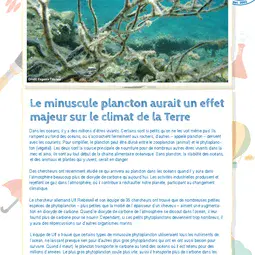
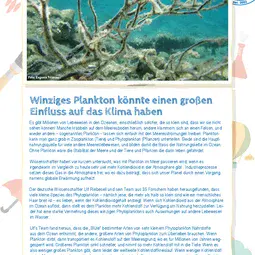
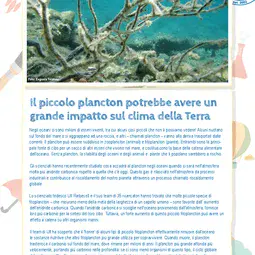
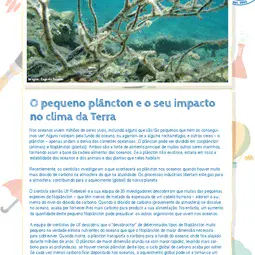
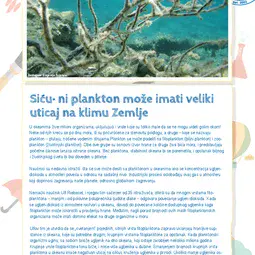
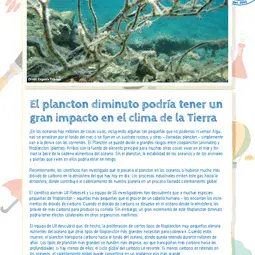
All English-language Planet Press releases are carefully edited, reviewed and proofed, by scientists, educators and EGU staff. Please note that once translated, Planet Press releases receive no further checks from EGU staff. For this reason, we cannot guarantee their accuracy, though we trust the quality of our voluntary translators and are grateful for their work.

